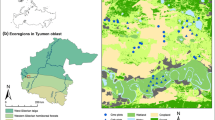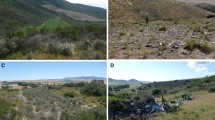Abstract
During the last 50 years, the distribution and abundance of many European butterfly species associated with semi-natural grasslands have declined. This may be the result of deteriorating habitat quality, but habitat loss, resulting in decreasing area and increasing isolation of remaining habitat, is also predicted to result in reduced species richness. To investigate the effects of habitat loss on species richness, we surveyed butterflies in semi-natural grasslands of similar quality and structure, but situated in landscapes of different habitat composition. Using spatially explicit habitat data, we selected one large (6–10 ha) and one small (0.5–2 ha) grassland site (pasture) in each of 24 non-overlapping 28.2 km2 landscapes belonging to three categories differing in the proportion of the area that consisted of semi-natural grasslands. After controlling for local habitat quality, species richness was higher in grassland sites situated in landscapes consisting of a high proportion of grasslands. Species richness was also higher in larger grassland sites, and this effect was more pronounced for sedentary than for mobile species. However, the number of species for a given area did not differ between large and small grasslands. There was also a significant relationship between butterfly species richness and habitat quality in the form of vegetation height and abundance of flowers. In contrast, butterfly density was not related to landscape composition or grassland size. When species respond differently to habitat area or landscape composition this leads to effects on community structure, and nestedness analysis showed that depauperate communities were subsets of richer ones. Both grassland area and landscape composition may have contributed to this pattern, implying that small habitat fragments and landscapes with low proportions of habitat are both likely to mainly contain common generalist species. Based on these results, conservation efforts should aim at preserving landscapes with high proportions of the focal habitat.


Similar content being viewed by others
References
Asher J, Warren M, Fox R, Harding P, Jeffcoate G, Jeffcoate S (2001) The Millennium Atlas of butterflies in Britain and Ireland. Oxford University Press, Oxford
Atmar W, Patterson BD (1993) The measure of order and disorder in the distribution of species in fragmented habitat. Oecologia 96:373–382
Battin J (2004) When good animals love bad habitats: ecological traps and the conservation of animal populations. Conserv Biol 18:1482–1491
Bergman K-O, Askling J, Ekberg O, Ignell H, Wahlman H, Milberg P (2004) Landscape effects on butterfly assemblages in an agricultural region. Ecography 27:619–628
Bruun M, Smith HG (2003) Landscape composition affects habitat use and foraging flight distances in breeding European starlings. Biol Conserv 114:179–187
Dennis RHL, Shreeve TG, Van Dyck H (2003) Towards a functional resource-based concept for habitat: a butterfly biology viewpoint. Oikos 102:417–426
Dias PC (1996) Sources and sinks in population biology. Trends Ecol Evol 11:326–330
Donald PF, Green RE, Heath MF (2001) Agricultural intensification and the collapse of Europe’s farmland bird populations. Proc R Soc Londr B 268:25–29
Ekstam U, Forshed N (1996) Äldre fodermarker. Naturvårdsverket, Stockholm
Fahrig L (2003) Effects of habitat fragmentation on biodiversity. Annu Rev Ecol Evol Syst 34:487–515
Fleishman E, Ray C, Sjögren-Gulve P, Boggs CL, Murphy DD (2002) Assessing the roles of patch quality, area, and isolation in predicting metapopulation dynamics. Conserv Biol 16:706–716
Gutiérrez D, León-Cortés JL, Menéndez R, Wilson RJ, Cowley MJR, Thomas CD (2001) Metapopulations of four lepidopteran herbivores on a single host plant, Lotus corniculatus. Ecology 82:1371–1386
Hanski I (1999) Metapopulation ecology. Oxford University Press, Oxford
Hanski I, Gaggiotti OE (2004) Ecology, genetics and evolution of metapopulations. Elsevier, Amsterdam
Hanski I, Ovaskainen O (2000) The metapopulation capacity of a fragmented landscape. Nature 404:755–758
Hanski I, Pakkala T, Kuussaari M, Lei G (1995) Metapopulation persistence of an endangered butterfly in a fragmented landscape. Oikos 72:21–28
Harrison S, Bruna E (1999) Habitat fragmentation and large-scale conservation: what do we know for sure? Ecography 22:225–232
Henriksen HJ, Kreutzer I (1982) The butterflies of Scandinavia in nature. Skandinavisk Bogforlag, Odense
James M, Gilbert F, Zalat S (2003) Thyme and isolation for the Sinai baton blue butterfly (Pseudophilotes sinaicus). Oecologia 134:445–453
Jonsson BG (2001) A null model for randomization tests of nestedness in species assemblages. Oecologia 127:309–313
Karsholt O, Razowski J (1996) The Lepidoptera of Europe. A distributional checklist. Apollo Books, Stenstrup
Kleijn D, Berendse F, Smit R, Gillissen N (2001) Agri-environment schemes do not effectively protect biodiversity in Dutch agricultural landscapes. Nature 413:723–725
Kruess A, Tscharntke T (2002) Grazing intensity and the diversity of grasshoppers, butterflies and trap-nesting bees and wasps. Conserv Biol 16:1570–1580
Lewis OT, Thomas CD, Hill JK, Brookes MI, Crane TPR, Graneau YA, Mallet JLB, Rose OC (1997) Three ways of assessing metapopulation structure in the butterfly Plebejus argus. Ecol Entomol 22:283–293
Lindborg R, Eriksson O (2004) Historical landscape connectivity affects present plant species diversity. Ecology 85:1840–1845
Littell RC, Milliken GA, Stroup WW, Wolfinger RD (1996) SAS system for mixed models. SAS Institute, Cary
Luoto M, Rekolainen S, Aakkula J, Pykälä J (2003) Loss of plant species richness and habitat connectivity in grasslands associated with agricultural change in Finland. Ambio 32:447–452
Maes D, van Dyck H (2001) Butterfly diversity loss in Flandres (north Belgium): Europes worst case scenario? Biol Conserv 99:263–276
Naumann CM, Tarmann GM, Tremewan WG (1999) The Western Palaearctic Zygaenidae. Apollo Books, Stenstrup
Öckinger E (2006) Possible metapopulation structure of the threatened butterfly Pyrgus armoricanus in Sweden. J Insect Conserv 10:43–51
Öckinger E, Hammarstedt O, Nilsson SG, Smith HG (2006) The relationship between local extinctions of grassland butterflies and increased soil nitrogen levels. Biol Conserv 128:564–573
Ouin A, Aviron S, Dover J, Burel F (2004) Complementation/supplementation of resources for butterflies in agricultural landscapes. Agric Ecosyst Environ 103:473–479
Pollard E, Yates TJ (1993) Monitoring butterflies for ecology and conservation. Chapman & Hall, London
Pulliam HR (1988) Sources, sinks, and population regulation. Am Nat 132:652–661
Rosenzweig ML (1995) Species diversity in time and space. Cambridge University Press, Cambridge
Smith RS, Shiel RS, Millward D, Corkhill P (2000) The interactive effects of management on the productivity and plant community structure of an upland meadow: an 8–year field trial. J Appl Ecol 37:1029–1043
Steffan-Dewenter I, Tscharntke T (2000) Butterfly community structure in fragmented habitats. Ecol Lett 3:449–456
Stoltze M (1996) Danske dagsommerfugle. Gyldendal, Copenhagen
Strijker D (2005) Marginal lands in Europe—causes of decline. Basic Appl Ecol 6:99–106
Sutcliffe OL, Thomas CD, Moss D (1996) Spatial synchrony and asynchrony in butterfly population dynamics. J Anim Ecol 65:85–95
Thomas CD, Hanski I (2004) Metapopulation dynamics in changing environments: butterfly responses to habitat and climate change. In: Hanski I, Gaggiotti OE (eds) Ecology, genetics and evolution of metapopulations. Elsevier, Amsterdam pp 489–514
Thomas CD, Kunin WE (1999) The spatial structure of populations. J Anim Ecol 68:647–657
Thomas JA, Bourn NAD, Clarke RT, Stewart KE, Simcox DJ, Pearman GS, Curtis R, Goodger B (2001) The quality and isolation of habitat patches both determine where butterflies persist in fragmented landscapes. Proc R Soc Lond B 268:1791–1796
Tscharntke T, Steffan-Dewenter I, Kruess A, Thies C (2002) Characteristics of insect populations on habitat fragments: a mini review. Ecol Res 17:229–239
van Swaay C, Warren M (1999) Red Data book of European butterflies (Rhopalocera). Council of Europe Publishing, Strasbourg
Vickery JA, Tallowin JR, Feber RE, Asteraki EJ, Atkinson PW, Fuller RJ, Brown VK (2001) The management of lowland neutral grasslands in Britain: effects of agricultural practices on birds and their food resources. J Appl Ecol 38:647–664
Wahlberg N, Klemetti T, Selonen V, Hanski I (2002) Metapopulation structure and movements in five species of checkerspot butterflies. Oecologia 130:33–43
Weibull A-C, Bengtsson J, Nohlgren E (2000) Diversity of butterflies in the agricultural landscape: the role of farming system and landscape heterogeneity. Ecography 23:743–750
Acknowledgments
We thank E. Cronvall for assistance with the field work and B.G. Jonsson for providing his RANDNEST-program. J. Bengtsson, S.G. Nilsson and three anonymous reviewers gave valuable comments on the manuscript. This study was financed by the Swedish Environmental Protection Agency through the research program “The Conservation Chain”. H.G.S. was supported by a grant from the Swedish Research Council for Environment, Agricultural Sciences and Spatial Planning (Formas). The study complies with current laws in Sweden.
Author information
Authors and Affiliations
Corresponding author
Additional information
Communicated by Ingolf Steffan-Dewenter
Rights and permissions
About this article
Cite this article
Öckinger, E., Smith, H.G. Landscape composition and habitat area affects butterfly species richness in semi-natural grasslands. Oecologia 149, 526–534 (2006). https://doi.org/10.1007/s00442-006-0464-6
Received:
Accepted:
Published:
Issue Date:
DOI: https://doi.org/10.1007/s00442-006-0464-6




